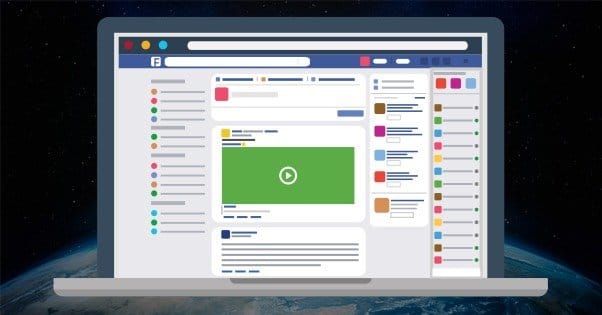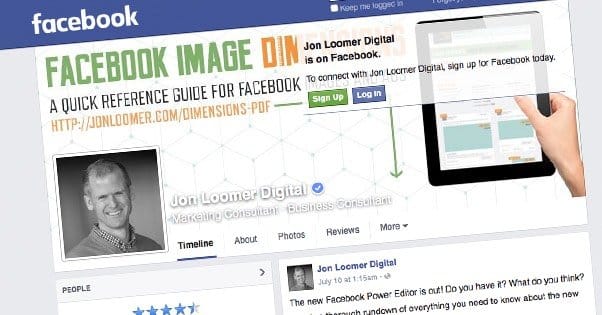 Written by ContentPowered.com
Written by ContentPowered.com
Marketing online is difficult. There are trillions of webpages, and they’re all vying for attention.
It’s even worse in a crucible like Facebook, where they’re all pushing for a limited amount of attention. The average person, according to Facebook, sees around 300 posts per day. This includes posts from friends, posts from businesses, and news feed ads. That’s an incredibly low number. If Facebook’s algorithm didn’t filter feeds, the average user would see more like 1500 posts per day.
How many brands are there on Facebook? How many brands do you think are competing for the attention of a single user? When only one in five posts makes it to the user, and friend/family posts are higher weight than business posts, how can a business hope to succeed? Is Facebook even worth using?
That’s the question you’re asking, and that’s the question I hope to answer. Or, rather, I hope to prove. I’ll answer right now; you can succeed, you can grow, you can market successfully on Facebook. Yes, even today, with lower reach and filtered feeds.
It’s just a matter of going about it properly.
Arguments Against Facebook
There are a few persistent arguments against using Facebook for business and brand building. I’d like to address them.
First is the idea that Facebook is no longer focused on the users. It seems at first glance that most of the changes Facebook makes are geared towards making the platform more money. Lowering post reach makes businesses spend more. Introducing new forms of ads make businesses experiment with money. This really isn’t true. Facebook has repeatedly made decisions that improve the user experience; just look at recent changes like reducing comment and like stories that users themselves claimed to dislike.
Declining post reach, by the way, is a symptom of the press of businesses trying to get attention. In a way, it’s our own fault. When a brand notices reach going down, they decide that to reach more users, they need to post more often. When they post more often, if they’re the only ones doing it, they receive more attention. Then other businesses catch on and everyone posts more often. This means there’s more competition for attention, Facebook has to do more filtering, and reach declines.
If, somehow, we could convince every business to dial back the number of posts they make per week, we would all see our reach go up. Unfortunately, the only way for this to happen would be for Facebook to implement harsh penalties for spamming, and lower the threshold for what constitutes spam. Nothing short of systemic change would get businesses to post less.
Another rumor is the persistent claim that Facebook is dying. There was one prominent study a year or so back that claimed Facebook was on the edge of a cliff, and that its userbase was going to collapse in the next few years. They performed that study by modeling what happened to other sites, like Myspace.
The main fault I have with that study is that it doesn’t really take into account the other side of the story. It claims users will leave in droves, but it doesn’t say where they will go or what they will do. When you look at Myspace, and you see the collapse of its usership, it looks seriously apocalyptic. But when you look at where those users went, you see something important; they all went to Facebook.
In order for Facebook to die in the sudden collapse the way Myspace did, some new site needs to come up as a Facebook Killer. Oh, certainly sites have tried. Ello is the most prominent one I can think of recently, but it was barely a blip on Facebook’s userbase. I know I got bored of it in about an hour.
I’m not ruling out the possibility of a Facebook Killer, but I don’t think there’s anything quite as potent on the horizon.
Probably the one valid criticism against Facebook I’ve seen is that it’s really complicated and difficult to use properly. This is, of course, true. That’s why businesses exist solely to manage Facebook pages for businesses. That’s why hundred-page guides are written to barely scratch the surface. That’s why there are so many horror stories of businesses trying, failing, and hurting themselves in their confusion.
Facebook is very effective if you know what you’re doing and you use it properly. Therein lies the problem; you need to know what you’re doing, and a lot of that knowledge comes from experience. Experience takes time and money, however, and most people come to Facebook for marketing because they want something cheap. If you don’t have a budget, you need to have the luxury of time. If you don’t have time or money, you’re going to need to dig deep and learn fast.
Now, there are two ways to market on Facebook. Ideally, you’ll use both of them. Most people start with the first and gradually adopt the second. I’m talking about organic marketing and paid marketing. It’s possible to succeed with just one or the other, but a mixture of both is best.
Free Marketing on Facebook
It’s entirely possible to market without spending a dime on Facebook. The thing you have to realize is, you’re trading that expense for your time. Money gives you access to paid advertising, which speeds up the process immensely, when you do it properly.
That said, free and paid marketing have somewhat different goals. Free marketing on Facebook is more about building an audience, building brand awareness, and getting engagement. It’s also good for customer service, although Twitter blows Facebook out of the water on that front.
By contrast, it’s very poor for promotional messages and long, rambling text posts. If you want to post something longer than a tweet, take it to your blog. Studies have shown that the ideal length for a Facebook post is actually shorter than the Twitter character limit. As for promotional posts, Facebook actively demotes them, so you’re doing yourself a disservice by posting them.
What do you post on Facebook, then? The ideal piece of content captures attention and gets shared. It’s a viral meme, but not in the “humorous picture with caption” sense of the word. Rather, I’m using meme in the original sense, as a bite-sized concept or idea. Viral photos and humor memes are certainly plausible, but they need to match your branding and voice. Many businesses just can’t pull that off.
Text posts can be valuable, but be aware that they aren’t weighted very heavily in EdgeRank. I’ll explain more about EdgeRank shortly. The ideal text post is a short, easy to answer question. “What would you do if you won $1M?” It’s not exactly brand related, unless you’re planning to give away a million bucks, but it’s going to get engagement out of people who have something interesting as an answer.
Narrow text posts with very little of interest, by contrast, aren’t going to do you any favors. People ignore them.
Links are weighted more heavily, and are better to post. You can link to your site, or you can link to other content. Linking to your site is obviously going to be the bulk of your posting. You want to get people to click through and visit your page
Photos are great to post, because everyone likes a big graphic, and a photo gets more screen real estate than a link preview image. On the other hand, a photo doesn’t link out to your site. Unless you’re clever, and put a link in the description. Photos, particularly compelling and interesting photos, can be shared easily and widely.
Videos are growing in popularity as well, but they’re harder because you need to have the ability to produce a quality video. If you do, though, consider posting it on Facebook as well as YouTube, because native videos on Facebook share better than YouTube links.
EdgeRank Explained
As I mentioned, different types of posts have different weights. A video is weighted more heavily than an image or a link, which are heavier than a text post, which is heavier than a promotional post or a spam post. Weight helps determine who should see a post, but there are two other factors.
One of the other factors is time. It’s pretty straightforward. A post has the most value the moment its posted. The longer it has been since it was posted, the less valuable the post is, and the less it will be seen.
The third factor is the most complex, and it’s your affinity score with any given user. It’s a calculation between you and that user, and it takes into account how often they see your posts, how often they click links, engage with posts, share posts, like posts, or visit your page. The more they do these actions, and the more often they do it, the more likely they are to see more of your posts.
That’s why engagement is so important on Facebook. The more people like and comment on your posts, the more they see subsequent posts.
Complete a Robust Profile
One of the first steps to success on Facebook, besides knowing what to post, is having a completed profile. I can’t tell you the number of times I’ve tried to help a business with their Facebook page only to find it sparsely populated. If you don’t even have a cover photo, or if your About section is half-filled, you have homework to do. Get back to me later.
It helps to upload a handful of pictures and other forms of media to make your page look a little more lived in, particularly if it’s new. Users rarely like being the first to do anything, other than those few people who love to comment “first!” on posts with no other value.
Create a Constant Stream of Quality Content
I know I talked about the problem with reach being a side effect of people posting a lot, but there’s nothing we can really do about that. Until Facebook makes a change to promote less frequent, higher quality content, we just have to live in the world we’re given.
That means you need to post consistently and constantly, in general about once per day. Some businesses will be able to support more frequent posting, but you’ll know when you reach that point. Most of the time, one post per day is fine. I’ve already given you a rundown of the sort of content you can post; all you need to do is work to schedule a bunch of posts to publish over the coming weeks.
Make Absolutely Certain Mobile Works
Facebook is becoming an increasingly mobile platform. Statistics from six months ago show that half a billion people on Facebook use the mobile app exclusively. That number is only going to rise as more people adopt mobile devices and apps as their primary means of communication.
That means you need to keep mobile in mind when you’re posting. With text, that’s no different from normal. With images, it means you need to post images that don’t look muddy or small on a mobile device. The biggest concern is that any site you link to, particularly your own, is functional on a mobile device. It’s a bit out of the realm of Facebook to make sure your site is responsive, but it’s really something you need to do.
Focus on Engagement Over Conversions
Many people look at Facebook marketing and think in the traditional sense of putting out messages, getting people in to convert. Organic marketing doesn’t work that way. You’re not generating leads, you’re building a community. If all you’re trying to do is sell products, you can do that with PPC or TV ads or billboards. Facebook is a two-way street, and you’re trying to make people identify with your brand. With organic posts, at least, you need to focus on engagement and community over leads and conversions. If all you’re doing is looking at the money, you’ll see a poor ROI and are likely to quit too soon.
Paid Marketing on Facebook
Now we get into the wonderful world of paid advertising on Facebook. This is where your money comes in, and it’s where it should be put to good use. With the right optimizations, you can get quite a bit of traffic for every dollar you spend. Of course, depending on your niche and your competition, that might be a bit higher. This is where the learning curve really gets steep, unfortunately, and it means you have a lot of research to do.
For starters, I recommend WordStream’s guide. It’s not specific to Facebook, but the general concepts and knowledge are all relevant.
Before we begin, though, I want to take a moment to talk about fake fans. Fake fans are Facebook “users” who aren’t actually real people. They may be run by bots, or by people running multiple accounts and getting paid to like content. It’s easy to run afoul of these people, just by leaving your ad targeting open to the wrong geographic locations. They will drain your budget and lower your organic reach, so avoid them if you can. Always do a spot scan of new followers and look for fakes to remove.
Use the Right Ad Objectives
The first key to success with paid ads on Facebook is to use the right ad objective. Ad objectives are basically a general set of rules Facebook uses to determine who gets to see your posts. Think of it like basic targeting that applies on top of any targeting you apply.
There are a handful of different objectives, which you can read about here. In general, you’re probably going to want to run page like ads, website conversion ads, and maybe video view ads. You’ll likely want to avoid website click ads, because the clicks can’t be cheap enough for the low conversion rate Facebook users typically exhibit.
Track Your Traffic
There are two ways you can track the traffic generated by your ads, and that’s not counting the basic tracking Facebook gives you through Insights or the on-site tracking you get through Google Analytics.
The first way is through Google’s UTM link parameters. These are specific flags added to the ends of URLs to give more information about the source of the link and the behavior of the user on your site, as viewed in Google Analytics. They’re easy to find, use, and read.
The second way is by implementing Facebook’s conversion tracking pixel. You put this code in the post-conversion confirmation page on your site, and then whenever a user clicks through a Facebook ad and goes on to convert, information about them is logged. You can use this to create retargeting audiences, as well as see what parts of your funnel work the best.
Test Everything, Always
The second key to success with Facebook PPC, and really any marketing in general, is to test your ads. Test variations in everything you can think to vary.
- Test large changes in image, by varying the subject, the color composition, and everything else.
- Test small changes in image, like adding a border or making the colors brighter.
- Test changes in the wording of your headlines.
- Test changes in the length and content of your ad copy.
- Test changes in the landing page you use to refer users to your site.
- Test changes in audience and geographic targeting.
You should always have variations on every ad running so you can optimize the ads you’re spending money on. Never run an ad based on a hunch; track concrete data and make changes based on that data.
Learn and Love Targeting Options
Arguably the biggest strength of Facebook ads is the ability to use a huge amount of data the site collects as targeting options. You can target people who like specific pages. You can target people in certain age ranges, education levels, or income levels. You can target people based on their past interaction with your site. It’s really robust and there’s a lot you can do with it.
One thing you should always do is limit your targeting to just the country in which you’re advertising. The vast majority of fake followers come from countries like the Philippines or India, so if only people browsing from the United States can see your ads, they won’t be subject to clickfarms. Whether you further narrow your geographic targeting or not is up to you.
Make Leads and Traffic Your Goal
Unlike organic marketing, where I said community building and brand awareness was your goal, paid marketing on Facebook is a lot more traditional. Your ads will be geared towards getting people to your site, where they ideally go on through your sales funnel to convert. Leads, traffic, and conversions are your goals here, so plan accordingly.
It takes a lot of work, but Facebook is very much still worth using. Just don’t go into it without the proper mindset. Trying to half-heartedly throw marketing at the wall won’t work, and it can even hurt you if you try to pick up the pieces later.







